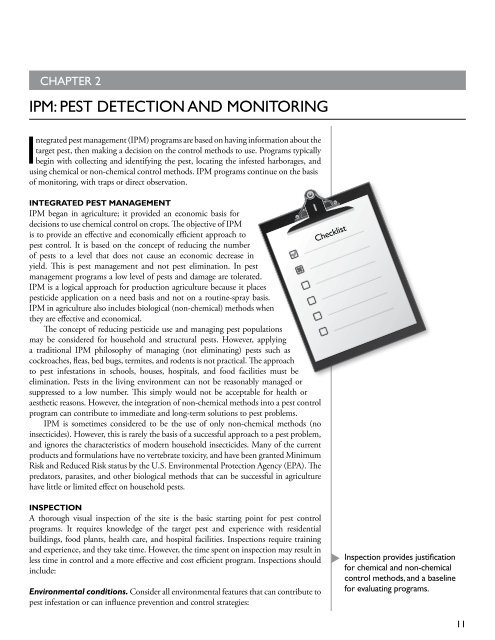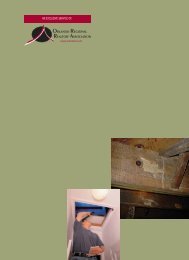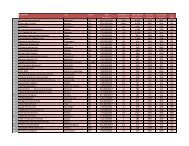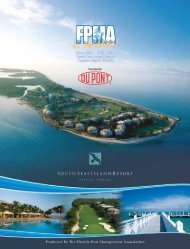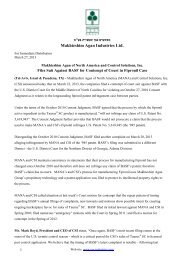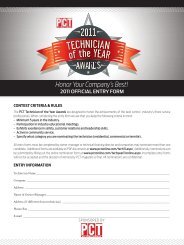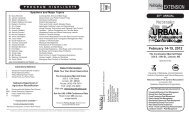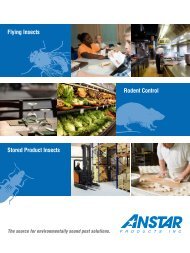table of contents - Pest Control Technology
table of contents - Pest Control Technology
table of contents - Pest Control Technology
Create successful ePaper yourself
Turn your PDF publications into a flip-book with our unique Google optimized e-Paper software.
CHAPTER 2<br />
IPM: PEST DETECTION AND MONITORING<br />
Integrated pest management (IPM) programs are based on having information about the<br />
target pest, then making a decision on the control methods to use. Programs typically<br />
begin with collecting and identifying the pest, locating the infested harborages, and<br />
using chemical or non-chemical control methods. IPM programs continue on the basis<br />
<strong>of</strong> monitoring, with traps or direct observation.<br />
INTEgrATEd pEST mANAgEmENT<br />
IPM began in agriculture; it provided an economic basis for<br />
decisions to use chemical control on crops. The objective <strong>of</strong> IPM<br />
is to provide an effective and economically efficient approach to<br />
pest control. It is based on the concept <strong>of</strong> reducing the number<br />
<strong>of</strong> pests to a level that does not cause an economic decrease in<br />
yield. This is pest management and not pest elimination. In pest<br />
management programs a low level <strong>of</strong> pests and damage are tolerated.<br />
IPM is a logical approach for production agriculture because it places<br />
pesticide application on a need basis and not on a routine-spray basis.<br />
IPM in agriculture also includes biological (non-chemical) methods when<br />
they are effective and economical.<br />
The concept <strong>of</strong> reducing pesticide use and managing pest populations<br />
may be considered for household and structural pests. However, applying<br />
a traditional IPM philosophy <strong>of</strong> managing (not eliminating) pests such as<br />
cockroaches, fleas, bed bugs, termites, and rodents is not practical. The approach<br />
to pest infestations in schools, houses, hospitals, and food facilities must be<br />
elimination. <strong>Pest</strong>s in the living environment can not be reasonably managed or<br />
suppressed to a low number. This simply would not be accep<strong>table</strong> for health or<br />
aesthetic reasons. However, the integration <strong>of</strong> non-chemical methods into a pest control<br />
program can contribute to immediate and long-term solutions to pest problems.<br />
IPM is sometimes considered to be the use <strong>of</strong> only non-chemical methods (no<br />
insecticides). However, this is rarely the basis <strong>of</strong> a successful approach to a pest problem,<br />
and ignores the characteristics <strong>of</strong> modern household insecticides. Many <strong>of</strong> the current<br />
products and formulations have no vertebrate toxicity, and have been granted Minimum<br />
Risk and Reduced Risk status by the U.S. Environmental Protection Agency (EPA). The<br />
predators, parasites, and other biological methods that can be successful in agriculture<br />
have little or limited effect on household pests.<br />
INSpECTION<br />
A thorough visual inspection <strong>of</strong> the site is the basic starting point for pest control<br />
programs. It requires knowledge <strong>of</strong> the target pest and experience with residential<br />
buildings, food plants, health care, and hospital facilities. Inspections require training<br />
and experience, and they take time. However, the time spent on inspection may result in<br />
less time in control and a more effective and cost efficient program. Inspections should<br />
include:<br />
Environmental conditions. Consider all environmental features that can contribute to<br />
pest infestation or can influence prevention and control strategies:<br />
Checklist<br />
Inspection provides justification<br />
for chemical and non-chemical<br />
control methods, and a baseline<br />
for evaluating programs.<br />
11


